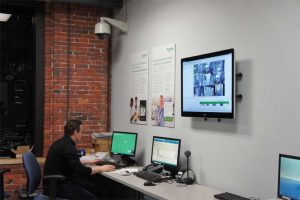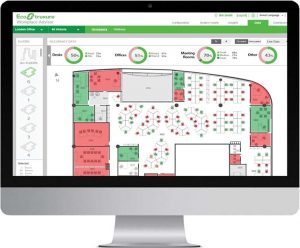
by Jeremy McCullough
The word ‘resiliency’ is often used in discussions related to preparing for or dealing with the after-effects of a hurricane or a flood, but it is an important consideration when managing various other types of disasters, too. Today’s construction specifiers and building owners are increasingly hearing this word because of a different type of emergency—a fiscal one.
This is not the first time the world is facing an economic downturn, and it certainly will not be the last. However, with universal stay-at-home orders,
it is one of the first times building occupancy is very low at such a large scale. How can owners weather the storm, take action now, and bounce back as life returns to normal? In the pursuit of resiliency, the industry is progressively turning to Internet of Things (IoT)-based design in building management systems, lighting, HVAC, controls, security, and more. This adoption not only saves time and money in the long run, but also makes buildings more attractive to prospective occupants, especially important in the competitive climate that is likely to occur in the coming months.
With today’s digital buildings, owners are afforded more tools than in traditional facilities, saving capital and investment, and ensuring the health and safety of all occupants. With the rise of millennials and Generation X in the workforce (38 percent in 2019 and a projected 58 percent in 2028), occupants and facility staff alike will expect—not just appreciate—connected buildings. The expectation, built from a digital-native life of smartphones, pervasive internet connectivity, and a growing investment in smart home devices, makes an IoT-based and digital workplace essentially mandatory. Incorporating that consideration into any construction project, whether a single building or an entire campus, ensures projects stand out among an abundance of options for prospective occupants or buyers, and remains resilient in the face of economic uncertainty.

Making the case for a digital building
One of the biggest hurdles that design professionals face when trying to integrate IoT-based and digital technologies is convincing stakeholders to buy into the decision in the first place, as these services are considered expensive, with little return on investment. Too often, clients are looking to build a property and sell it quickly, with no consideration for the ultimate end-user’s comfort or ease of use. However, this discards the added value IoT implementation can tack on to the sale price. Digital implementors today are seeing large increases in rental and occupancy rates, as well as a very significant rise in the sell-through number—as much as 15:1—in additional monetary return when the building is sold.
The conversation to garner buy-in is important, but that is only truly effective when done at the very beginning of the specifying process—and only when it is between all verticals and disciplines involved. To conduct a successful project, all parties must be at the table to discuss the how and the why from the outset. If not, it could create greater costs in the long run. For example, imagine an electrical specifier makes the decision to digitize the building, and, therefore, adds a motorized breaker control system to the design. However, the general contractor decides to remove it from the job due to perceived costs. Ultimately, the mechanical team will have to adjust their installation and include onsite buildout of an additional panel, CTs, and relays because the digital communication in the motorized breaker is no longer available. In the end, the cost of removing the motorized panel is greater than if they would have left it in the job. Also, it would have provided a nicer, more efficient solution for the end-user.
To reach a consensus on the utility of a digital building, a design professional can then highlight the numerous advantages of IoT-solutions.
Remote management & 24/7 commissioning
In this day and age, remote management is important, giving facility managers and owners the flexibility to operate a building or multiple structural portfolios without being onsite. This is useful when a time-sensitive issue arises during off-hours, which in a traditional building would take up to 48 hours and a significant dollar spend to address. Without an IoT-based system, course correction would involve rolling a maintenance truck out to identify the issue after hours; then if maintenance does not have the tools or knowledge on hand to fix, they would have to leave and then return to the site; get connected; troubleshoot the issue; and ultimately fix it. With a digital building and its connected metering, HVAC, and lighting, among other installations, facility managers can pinpoint exactly what is going on and often put the system back in use remotely within minutes. Even if it is not possible to fix remotely, like a broken valve, one can still send in an appropriately trained maintenance crew, armed with complete knowledge of the issue and the exact tools they need to fix the valve—saving everyone involved time and money.




